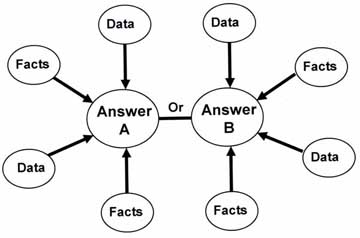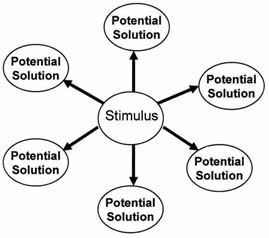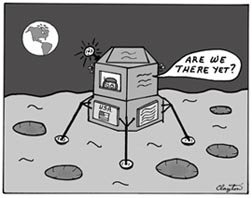|
Convergent Verses Divergent ThinkingDivergent and Convergent thinking skills are both important aspects of intelligence, problem solving and critical thinking.
Convergent ThinkingBringing facts and data together from various sources and then applying logic and knowledge to solve problems, achieve objectives or to make informed decisions is known as thinking convergently. The deductive logic that the fictional character Sherlock Homes used is a good example of convergent thinking. Gathering various tidbits of facts and data he was able to put the pieces of a puzzle together and come up with a logical answer to the question: Who done it? "When you have eliminated the impossible, whatever remains, however improbable, must be the truth." ~ Sir Arthur Conan Doyle
Convergent Thinking
Divergent ThinkingDivergent Thinking is thinking outwards instead of inward. It is the ability to develop original and unique ideas and then come up with a problem solution or achieve an objective. Einstein was a strong divergent thinker. He asked simple questions and then did mental exercises to solve problems. For example, as a young man Einstein asked himself what it would be like to ride on a beam of light. It took him many years of thought experiments, however the answer helped him develop the special theory of relativity.
Note: Thought experiments are imagined scenarios to understand the way things work.
"Imagination is more important than knowledge."
Divergent Thinking Standard IQ tests gauge convergent thinking. Pattern recognition, testing knowledge, logic thought flow and the ability to solve problems can all be tested and graded. However,there are no accurate tests able to measure divergent thinking skills. It’s not surprising that creative skills can’t be tested. How would one construct a test to determine divergent thinking capabilities? Did Leonardo da Vinci’s creation of the Mona Lisa take more brain power than Einstein’s equation E= MC²? Is the design of the Opera house in Sydney Australia more creative than Margaret Mitchell’s novel Gone with the Wind? Is Alvin Toffler’s book Future Shock more inspired than Salvador Dali’s painting of the melting clocks? Who’s to say which of these examples is more creative? Does public opinion decide what how much creativity was required for something, or is in the eye of the beholder? These are interesting philosophical questions, and ones that are enjoyable to talk about at parties, however aren’t useful to discover how to creatively think. A more useful question is: How can divergent and convergent thinking be improved and utilized to strengthen your critical thinking skills? Divergent and convergent thinking skills are both important to critical thinking. Not only that, they are interrelated. Deductive reasoning looks inward to find a solution, while divergent reasoning looks outward for a solution. Following the facts and data to determine the answer to a problem is not significantly different than having a spark of a thought and then coming up with a solution. Some of the same mental processes are used. Both require critical thinking skills to be effective. Both are used for solving problems, doing projects and achieving objectives. In other words, Divergent and Convergent thinking skills are two sides to the same coin—of critical thinking. One without the other doesn’t make sense. Both start with asking simple questions from a curious mind. Both can be strengthened by an insatiable curiosity and strong willingness to learn about the world and the people in it.
Here is an example: The dream of traveling beyond the reaches of earth’s gravity has been around since men and women first looked up at the stars. It’s wasn’t until the middle of the 20th century that technology became available that would make space travel possible. On October 14 th of 1957 Sputnik was launched by the Russians and the space race began. The United States was shocked when beaten by the Russians in technology. In response the US formed the National Aeronautics and Space Administration in 1958. In the early 1960s John Kennedy sent letters to top people in the aerospace industry including Wernher von Braun. He asked how the US could beat the Russians in the space race. Von Braun answered saying that the United States couldn’t beat them in building a space station; however we could beat them in a race to the moon. John Kennedy had done his homework by getting expert advice before giving his famous speech vowing to transport a man to the moon and bring him safely home by the end of the decade. His speech helped galvanize almost 400,000 NASA employees and contractors to work as a cohesive team and accomplish one of the greatest feats of history in less than a decade! Kennedy used facts and data to determine how we could beat the Russians into space. That was primarily convergent thinking.
The required development of many new technologies to design and build the rockets, spacesuits, lunar modules and other equipment to perform this amazing feat required a great deal of divergent thinking.
“The only way to discover the limits of the possible is to go beyond them into the impossible.” ~Arthur C. Clarke Do you want to unlock the power of critical thinking and create an amazing future? If so, click the link and get your copy of Mastering Critical Thinking today! Return from Convergent Thinking to Problem Solving Techniques |




